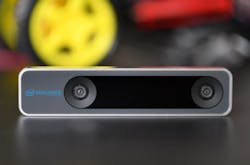Self-contained tracking camera from Intel targets robots and autonomous devices
New from theIntelRealSenseline of products is the T265 standalone tracking camera, which uses proprietary visual inertial odometry simultaneous localization and mapping (V-SLAM) technology with computing at the edge for accurate and low-latency tracking for applications such as robotics, drones, augmented reality (AR), and virtual reality.
Intel’s RealSense Tracking Camera T265 uses inside-out tracking, meaning that the device does not rely on any external sensors to understand the environment. Unlike other inside-out tracking, according to Intel, this camera delivers 6-degrees-of-freedom (6DoF) inside-out tracking by gathering inputs from two onboard fisheye cameras. The V-SLAM systems construct and continuously update maps of unknown environments and the location of a device within that environment, and since all position calculations are performed directly on the device, tracking with the T265 is platform independent and allows the T265 to run on very low-compute devices, says Intel.
The camera features the Intel Movidius Myriad 2 vision processing unit, which handles all data processing for tracking on the device. The Myriad 2 VPU is a System-on-Chip system that is equipped with two traditional 32-bit RISC processor cores as well as 12 unique SHAVE vector processing cores.
For its image sensors, the camera features two OV9282 CMOS image sensors from OmniVision Technologies with fisheye lenses for a combined, close to hemispherical 163±5° field of view for robust tracking even with fast motion. OV9282 image sensors are 1 MPixel black and white CMOS image sensors with a 3.0 µm pixel size that can achieve frame rates of 120 fps at full resolution.
Unlike previous Intel RealSense models, the T265 is not a depth camera. Intel does note that it is possible to use the image feed from the two fisheye lenses and sensors to compute dense depth, but the results would be poor compared to other RealSense depth cameras, as the lenses are optimized for wide tracking field of view, rather than depth precision, and there is no texture projected onto the environment to aid in depth fill.
Additionally, the camera—which begins shipping February 28 at $199—features a BMI055 inertial measurement unit from Bosch Sensortec, which enables the accurate measurement of rotation and acceleration of the device to feed into the V-SLAM algorithms, which are run on the VPU. The only hardware requirements for the devices are sufficient non-volatile memory to boot the camera, and a USB 2.0 or 3.0 connection providing 1.5 W of power.
Intel suggests that the camera is suitable for applications where tracking the location of a device is important, especially in locations without GPS service, such as warehouses or remote outdoor areas where the camera uses a combination of known and unknown data to navigate to its destination. It is also designed for flexible implementation and can be added to small-footprint mobile devices such as robots and drones, as well as for connectivity with mobile phones or AR headsets.
One example offered by Intel is the integration of the T265 into a robot designed for agriculture, which will allow the device to navigate fields in a "precision lawnmower-style pattern, and intelligently adapt to avoid obstacles in its environment, including structures or people."
"Understanding your environment is a critical component for many devices. The T265 was designed to complement our existing Intel RealSense Depth Cameras and provide a quick path to product development with our next-generation integrated V-SLAM technology," said Sagi Ben Moshe, vice president and general manager, Intel RealSense Group
View more information on the T265 tracking camera from Intel.
Share your vision-related news by contacting James Carroll, Senior Web Editor, Vision Systems Design
To receive news like this in your inbox, click here.
Join our LinkedIn group | Like us on Facebook | Follow us on Twitter
About the Author

James Carroll
Former VSD Editor James Carroll joined the team 2013. Carroll covered machine vision and imaging from numerous angles, including application stories, industry news, market updates, and new products. In addition to writing and editing articles, Carroll managed the Innovators Awards program and webcasts.
